A Study of Transformational Leadership and Job Performance at Aviva UK
VerifiedAdded on 2020/07/23
|27
|4360
|66
Project
AI Summary
This research project examines the impact of transformational leadership on employee job performance within Aviva Insurance UK Ltd, focusing on the role of Human Resource Management (HRM) in fostering team performance. The study investigates how transformational leadership, characterized by inspirational motivation, intellectual stimulation, and individualized consideration, influences employee motivation, problem-solving abilities, and overall job satisfaction. The project includes a critical review of existing literature, outlining the key concepts and theories of leadership, followed by a detailed methodology employing a social constructivism approach and semi-structured interviews with team leaders and members to gather primary data. The research aims to understand how transformational leaders manage teams, identify the impact of this leadership style on motivation and performance, and assess its effectiveness in addressing employee challenges within the competitive landscape of the UK insurance industry. The action program outlines the project's timeline, from topic selection to presentation, ensuring a structured approach to data collection and analysis.
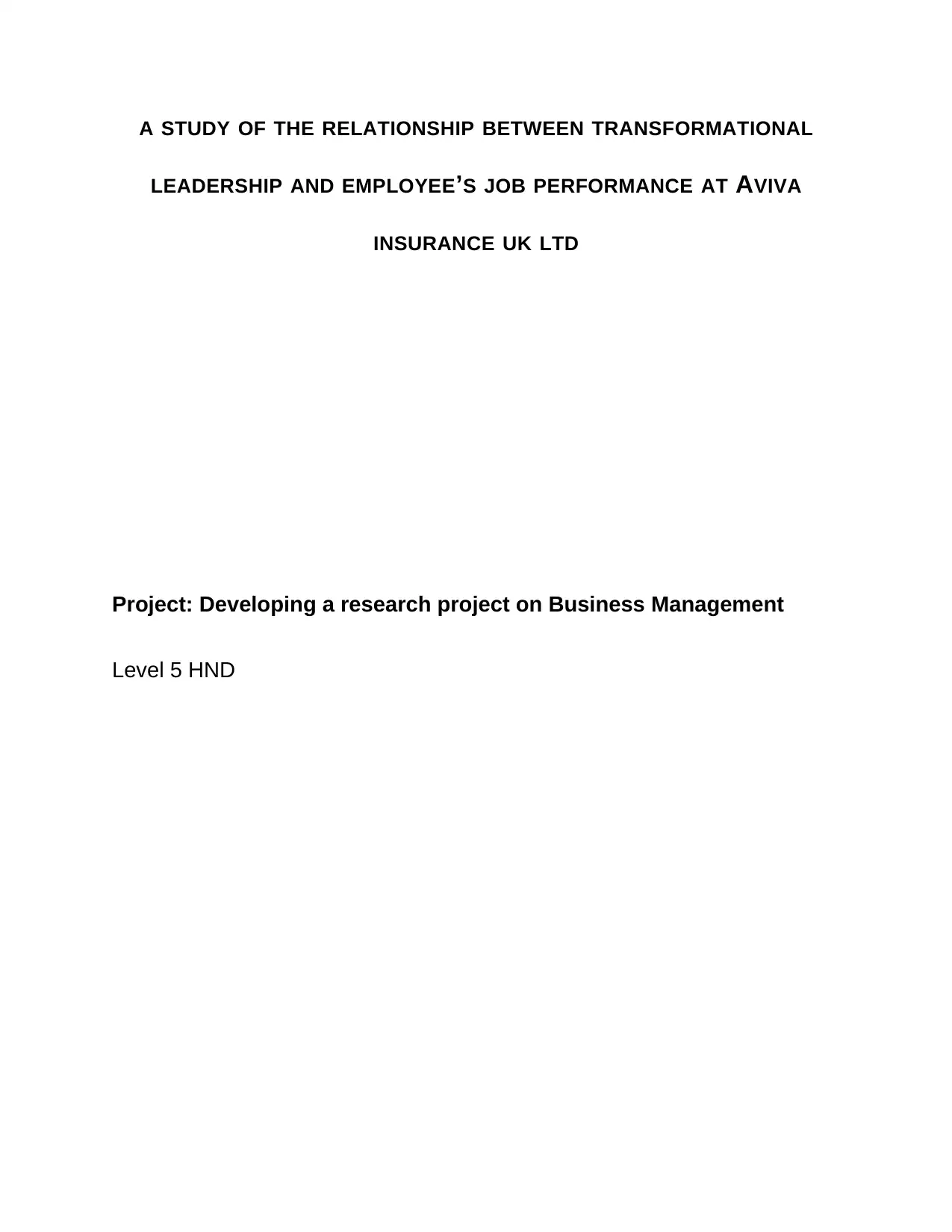
A STUDY OF THE RELATIONSHIP BETWEEN TRANSFORMATIONAL
LEADERSHIP AND EMPLOYEE’S JOB PERFORMANCE AT AVIVA
INSURANCE UK LTD
Project: Developing a research project on Business Management
Level 5 HND
LEADERSHIP AND EMPLOYEE’S JOB PERFORMANCE AT AVIVA
INSURANCE UK LTD
Project: Developing a research project on Business Management
Level 5 HND
Paraphrase This Document
Need a fresh take? Get an instant paraphrase of this document with our AI Paraphraser
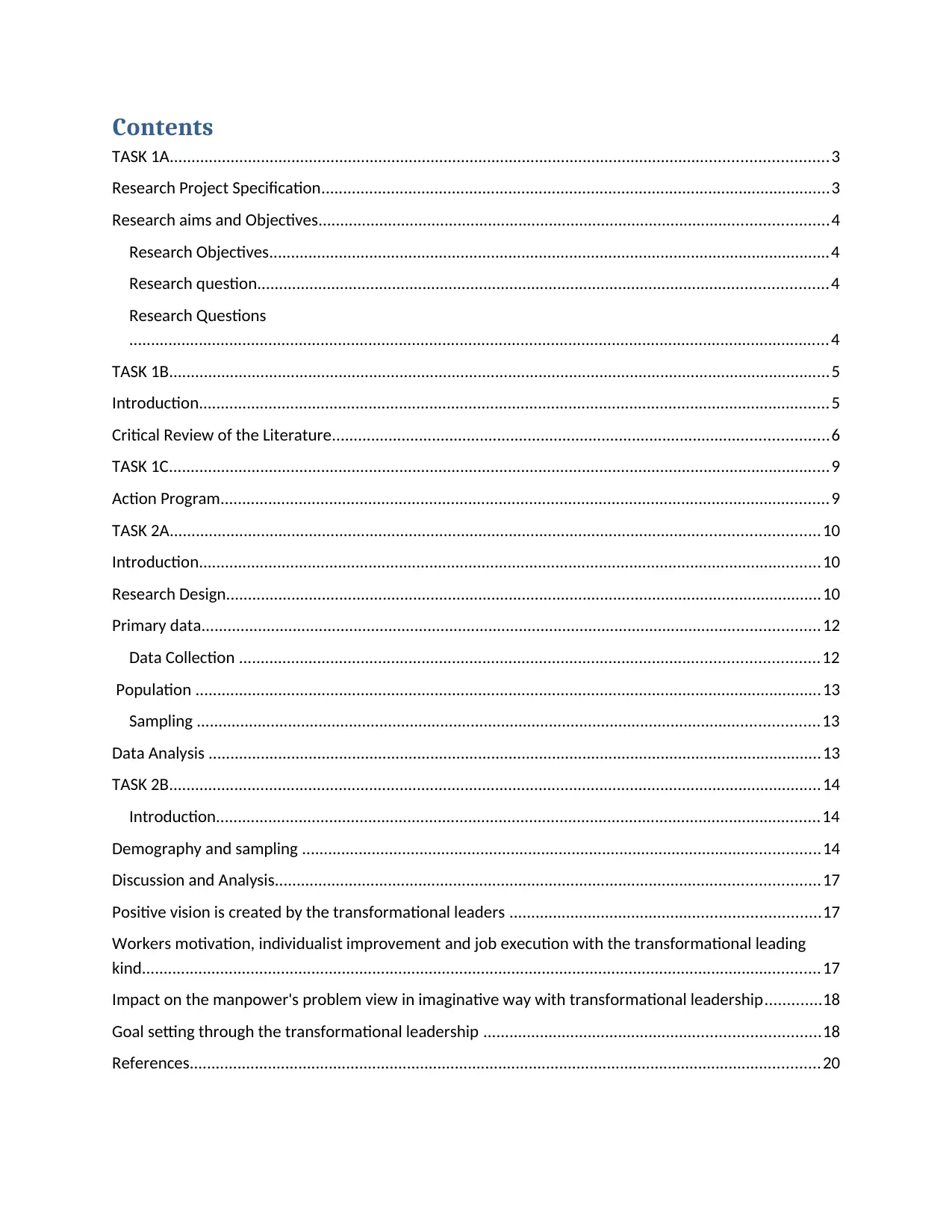
Contents
TASK 1A.......................................................................................................................................................3
Research Project Specification.....................................................................................................................3
Research aims and Objectives.....................................................................................................................4
Research Objectives.................................................................................................................................4
Research question...................................................................................................................................4
Research Questions
.................................................................................................................................................................4
TASK 1B........................................................................................................................................................5
Introduction.................................................................................................................................................5
Critical Review of the Literature..................................................................................................................6
TASK 1C........................................................................................................................................................9
Action Program............................................................................................................................................9
TASK 2A.....................................................................................................................................................10
Introduction...............................................................................................................................................10
Research Design.........................................................................................................................................10
Primary data..............................................................................................................................................12
Data Collection .....................................................................................................................................12
Population ................................................................................................................................................13
Sampling ...............................................................................................................................................13
Data Analysis .............................................................................................................................................13
TASK 2B......................................................................................................................................................14
Introduction...........................................................................................................................................14
Demography and sampling .......................................................................................................................14
Discussion and Analysis.............................................................................................................................17
Positive vision is created by the transformational leaders .......................................................................17
Workers motivation, individualist improvement and job execution with the transformational leading
kind............................................................................................................................................................17
Impact on the manpower's problem view in imaginative way with transformational leadership.............18
Goal setting through the transformational leadership .............................................................................18
References.................................................................................................................................................20
TASK 1A.......................................................................................................................................................3
Research Project Specification.....................................................................................................................3
Research aims and Objectives.....................................................................................................................4
Research Objectives.................................................................................................................................4
Research question...................................................................................................................................4
Research Questions
.................................................................................................................................................................4
TASK 1B........................................................................................................................................................5
Introduction.................................................................................................................................................5
Critical Review of the Literature..................................................................................................................6
TASK 1C........................................................................................................................................................9
Action Program............................................................................................................................................9
TASK 2A.....................................................................................................................................................10
Introduction...............................................................................................................................................10
Research Design.........................................................................................................................................10
Primary data..............................................................................................................................................12
Data Collection .....................................................................................................................................12
Population ................................................................................................................................................13
Sampling ...............................................................................................................................................13
Data Analysis .............................................................................................................................................13
TASK 2B......................................................................................................................................................14
Introduction...........................................................................................................................................14
Demography and sampling .......................................................................................................................14
Discussion and Analysis.............................................................................................................................17
Positive vision is created by the transformational leaders .......................................................................17
Workers motivation, individualist improvement and job execution with the transformational leading
kind............................................................................................................................................................17
Impact on the manpower's problem view in imaginative way with transformational leadership.............18
Goal setting through the transformational leadership .............................................................................18
References.................................................................................................................................................20
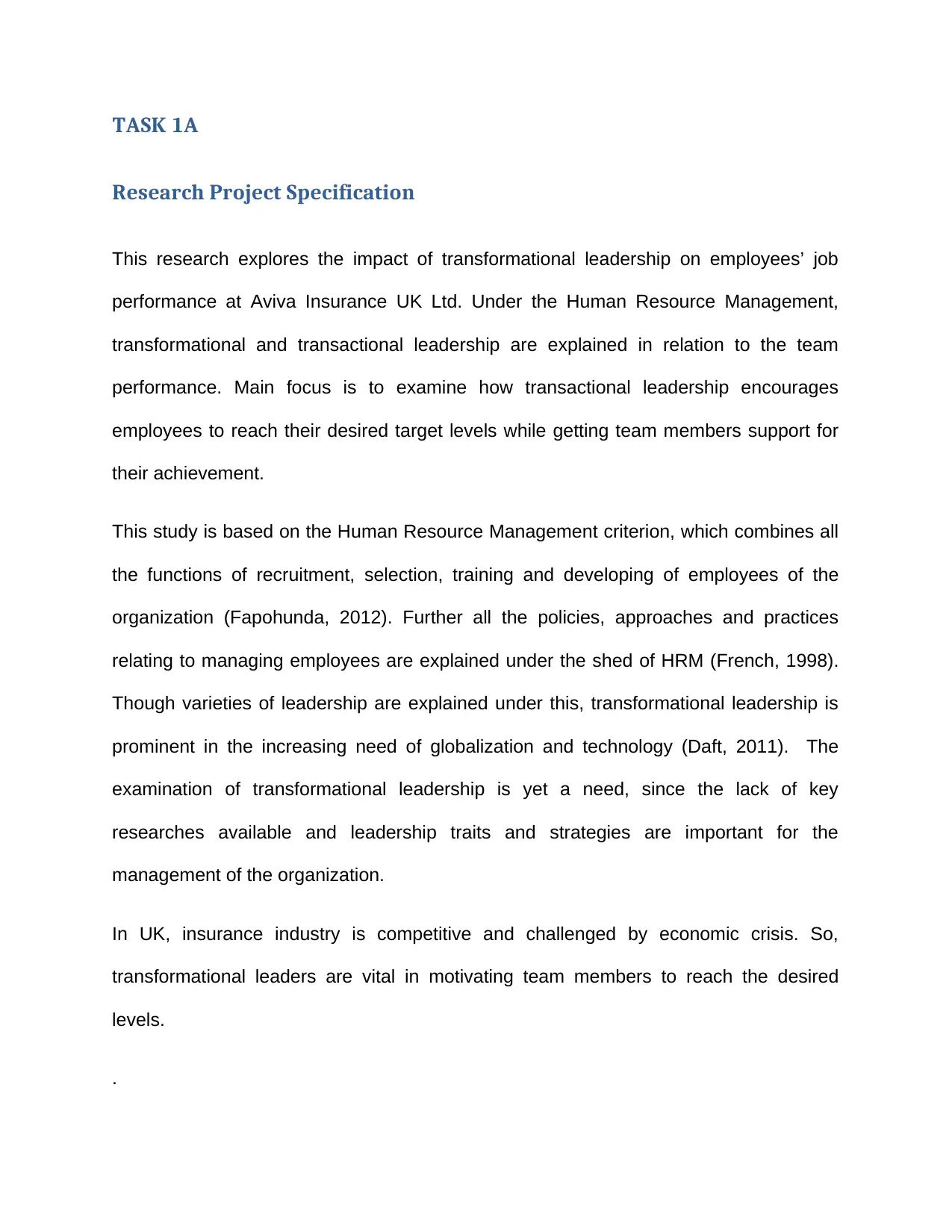
TASK 1A
Research Project Specification
This research explores the impact of transformational leadership on employees’ job
performance at Aviva Insurance UK Ltd. Under the Human Resource Management,
transformational and transactional leadership are explained in relation to the team
performance. Main focus is to examine how transactional leadership encourages
employees to reach their desired target levels while getting team members support for
their achievement.
This study is based on the Human Resource Management criterion, which combines all
the functions of recruitment, selection, training and developing of employees of the
organization (Fapohunda, 2012). Further all the policies, approaches and practices
relating to managing employees are explained under the shed of HRM (French, 1998).
Though varieties of leadership are explained under this, transformational leadership is
prominent in the increasing need of globalization and technology (Daft, 2011). The
examination of transformational leadership is yet a need, since the lack of key
researches available and leadership traits and strategies are important for the
management of the organization.
In UK, insurance industry is competitive and challenged by economic crisis. So,
transformational leaders are vital in motivating team members to reach the desired
levels.
.
Research Project Specification
This research explores the impact of transformational leadership on employees’ job
performance at Aviva Insurance UK Ltd. Under the Human Resource Management,
transformational and transactional leadership are explained in relation to the team
performance. Main focus is to examine how transactional leadership encourages
employees to reach their desired target levels while getting team members support for
their achievement.
This study is based on the Human Resource Management criterion, which combines all
the functions of recruitment, selection, training and developing of employees of the
organization (Fapohunda, 2012). Further all the policies, approaches and practices
relating to managing employees are explained under the shed of HRM (French, 1998).
Though varieties of leadership are explained under this, transformational leadership is
prominent in the increasing need of globalization and technology (Daft, 2011). The
examination of transformational leadership is yet a need, since the lack of key
researches available and leadership traits and strategies are important for the
management of the organization.
In UK, insurance industry is competitive and challenged by economic crisis. So,
transformational leaders are vital in motivating team members to reach the desired
levels.
.
⊘ This is a preview!⊘
Do you want full access?
Subscribe today to unlock all pages.

Trusted by 1+ million students worldwide
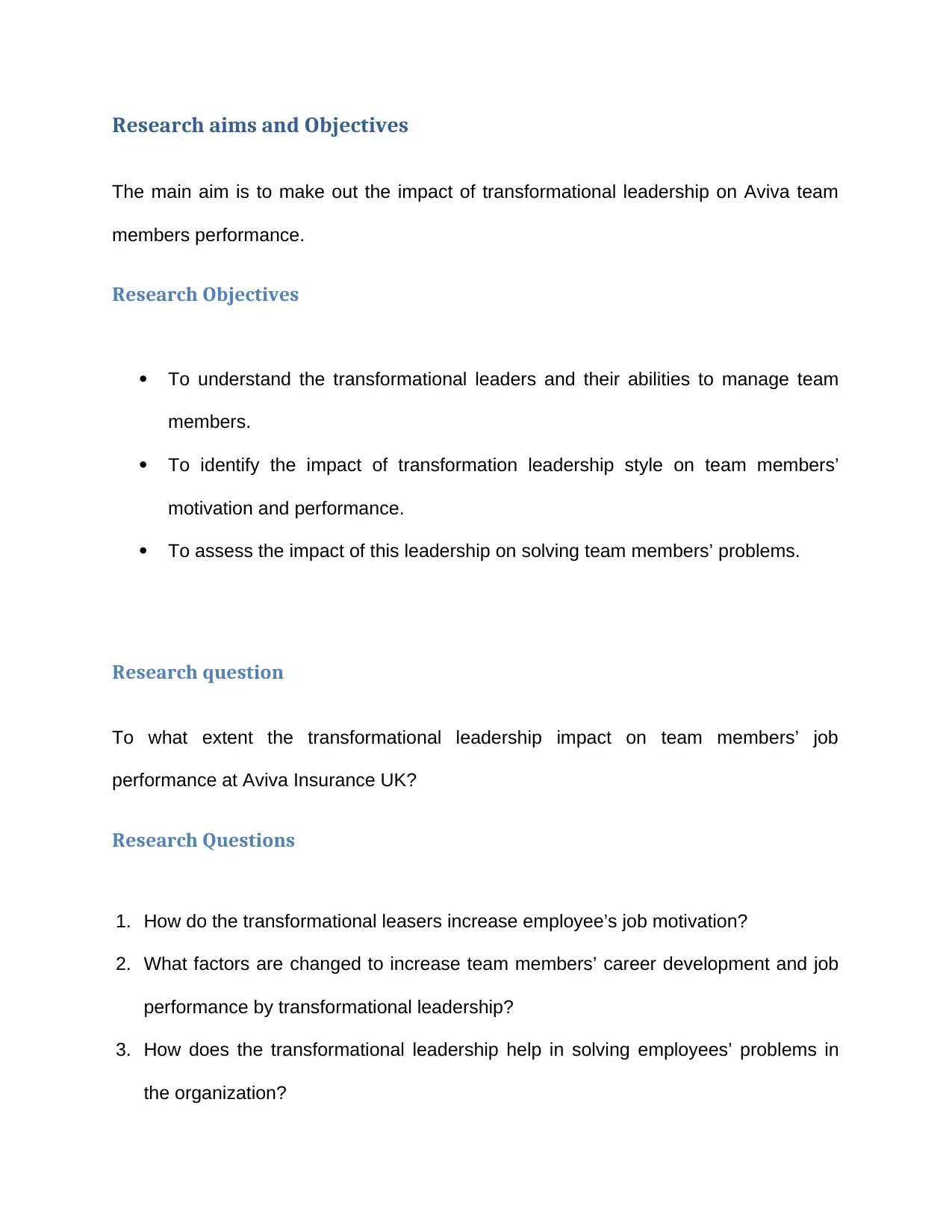
Research aims and Objectives
The main aim is to make out the impact of transformational leadership on Aviva team
members performance.
Research Objectives
To understand the transformational leaders and their abilities to manage team
members.
To identify the impact of transformation leadership style on team members’
motivation and performance.
To assess the impact of this leadership on solving team members’ problems.
Research question
To what extent the transformational leadership impact on team members’ job
performance at Aviva Insurance UK?
Research Questions
1. How do the transformational leasers increase employee’s job motivation?
2. What factors are changed to increase team members’ career development and job
performance by transformational leadership?
3. How does the transformational leadership help in solving employees’ problems in
the organization?
The main aim is to make out the impact of transformational leadership on Aviva team
members performance.
Research Objectives
To understand the transformational leaders and their abilities to manage team
members.
To identify the impact of transformation leadership style on team members’
motivation and performance.
To assess the impact of this leadership on solving team members’ problems.
Research question
To what extent the transformational leadership impact on team members’ job
performance at Aviva Insurance UK?
Research Questions
1. How do the transformational leasers increase employee’s job motivation?
2. What factors are changed to increase team members’ career development and job
performance by transformational leadership?
3. How does the transformational leadership help in solving employees’ problems in
the organization?
Paraphrase This Document
Need a fresh take? Get an instant paraphrase of this document with our AI Paraphraser
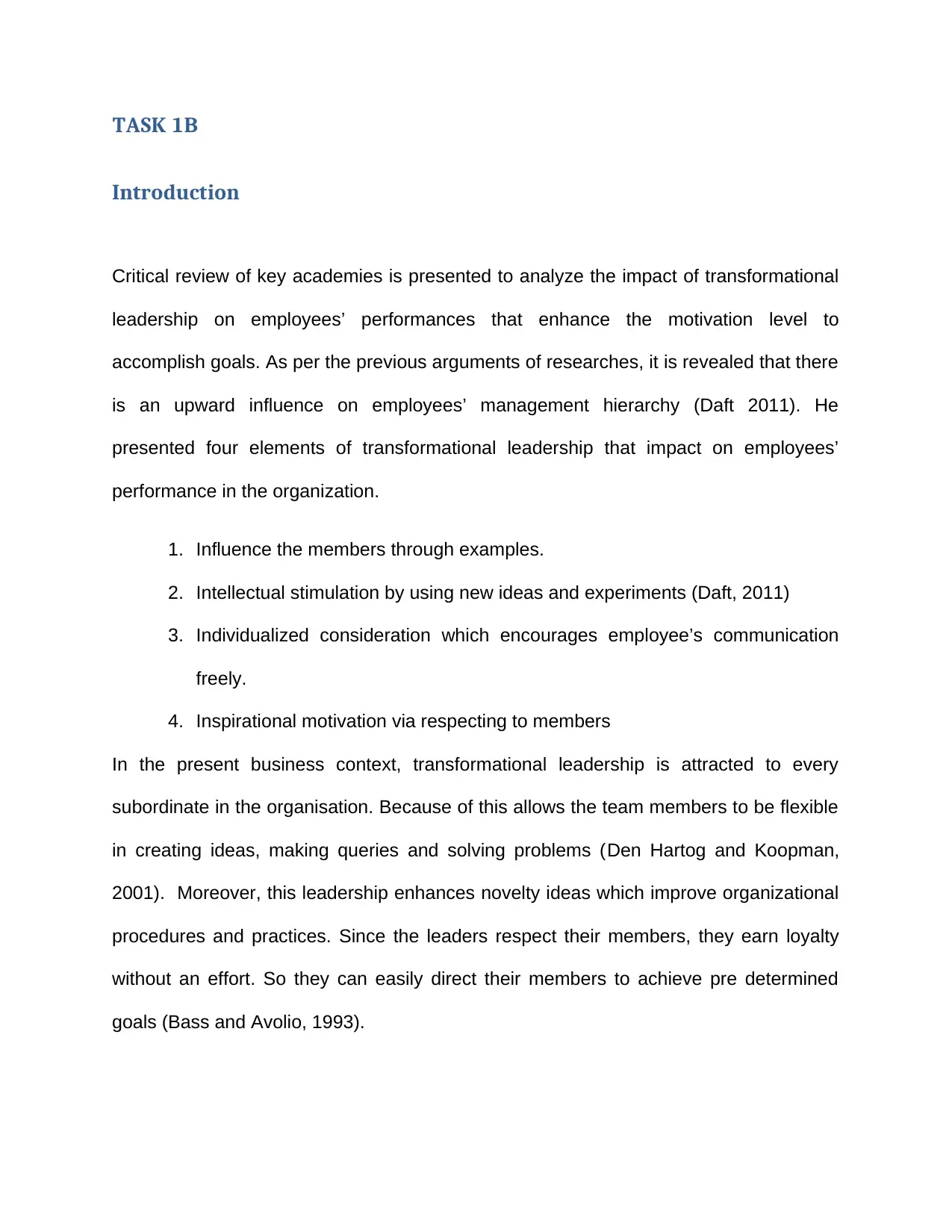
TASK 1B
Introduction
Critical review of key academies is presented to analyze the impact of transformational
leadership on employees’ performances that enhance the motivation level to
accomplish goals. As per the previous arguments of researches, it is revealed that there
is an upward influence on employees’ management hierarchy (Daft 2011). He
presented four elements of transformational leadership that impact on employees’
performance in the organization.
1. Influence the members through examples.
2. Intellectual stimulation by using new ideas and experiments (Daft, 2011)
3. Individualized consideration which encourages employee’s communication
freely.
4. Inspirational motivation via respecting to members
In the present business context, transformational leadership is attracted to every
subordinate in the organisation. Because of this allows the team members to be flexible
in creating ideas, making queries and solving problems (Den Hartog and Koopman,
2001). Moreover, this leadership enhances novelty ideas which improve organizational
procedures and practices. Since the leaders respect their members, they earn loyalty
without an effort. So they can easily direct their members to achieve pre determined
goals (Bass and Avolio, 1993).
Introduction
Critical review of key academies is presented to analyze the impact of transformational
leadership on employees’ performances that enhance the motivation level to
accomplish goals. As per the previous arguments of researches, it is revealed that there
is an upward influence on employees’ management hierarchy (Daft 2011). He
presented four elements of transformational leadership that impact on employees’
performance in the organization.
1. Influence the members through examples.
2. Intellectual stimulation by using new ideas and experiments (Daft, 2011)
3. Individualized consideration which encourages employee’s communication
freely.
4. Inspirational motivation via respecting to members
In the present business context, transformational leadership is attracted to every
subordinate in the organisation. Because of this allows the team members to be flexible
in creating ideas, making queries and solving problems (Den Hartog and Koopman,
2001). Moreover, this leadership enhances novelty ideas which improve organizational
procedures and practices. Since the leaders respect their members, they earn loyalty
without an effort. So they can easily direct their members to achieve pre determined
goals (Bass and Avolio, 1993).
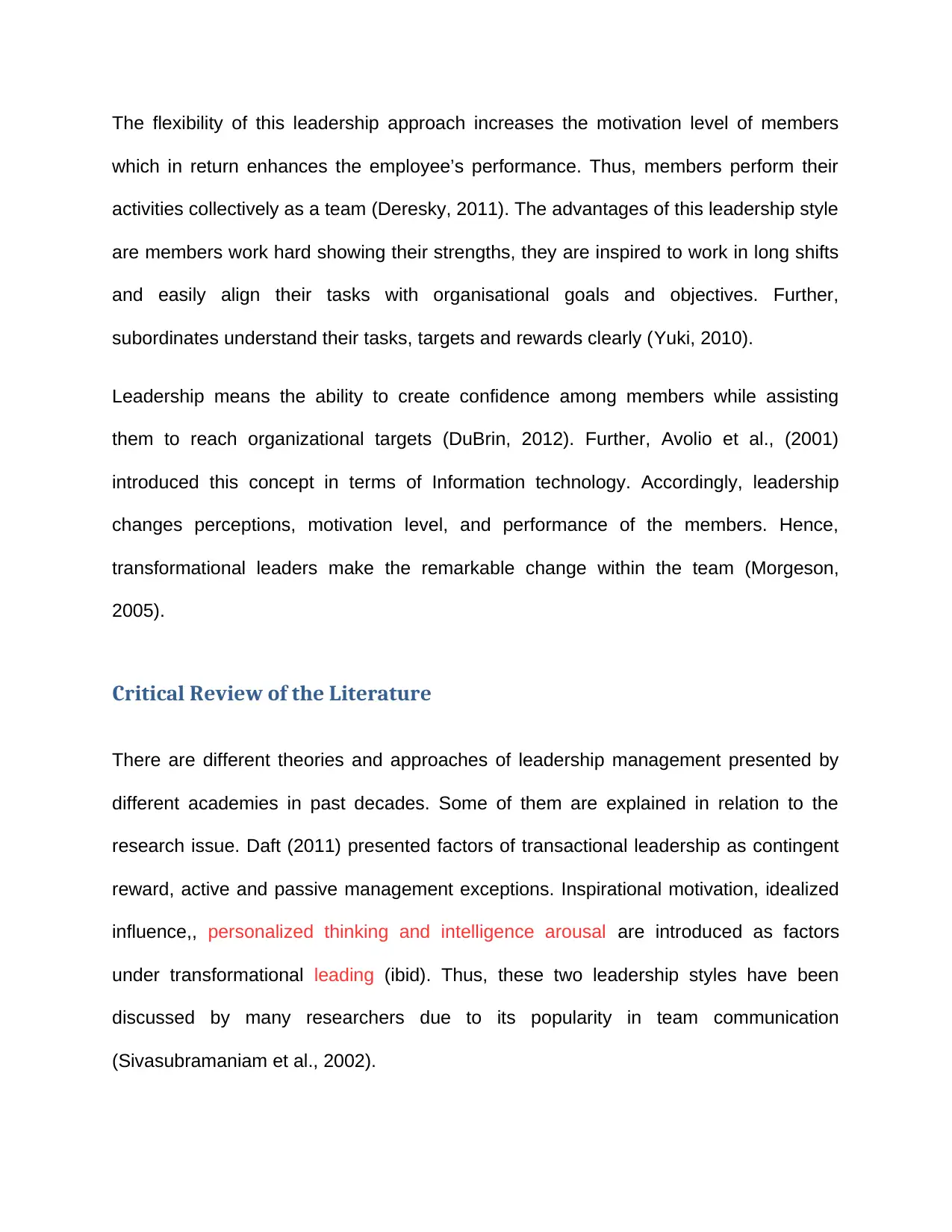
The flexibility of this leadership approach increases the motivation level of members
which in return enhances the employee’s performance. Thus, members perform their
activities collectively as a team (Deresky, 2011). The advantages of this leadership style
are members work hard showing their strengths, they are inspired to work in long shifts
and easily align their tasks with organisational goals and objectives. Further,
subordinates understand their tasks, targets and rewards clearly (Yuki, 2010).
Leadership means the ability to create confidence among members while assisting
them to reach organizational targets (DuBrin, 2012). Further, Avolio et al., (2001)
introduced this concept in terms of Information technology. Accordingly, leadership
changes perceptions, motivation level, and performance of the members. Hence,
transformational leaders make the remarkable change within the team (Morgeson,
2005).
Critical Review of the Literature
There are different theories and approaches of leadership management presented by
different academies in past decades. Some of them are explained in relation to the
research issue. Daft (2011) presented factors of transactional leadership as contingent
reward, active and passive management exceptions. Inspirational motivation, idealized
influence,, personalized thinking and intelligence arousal are introduced as factors
under transformational leading (ibid). Thus, these two leadership styles have been
discussed by many researchers due to its popularity in team communication
(Sivasubramaniam et al., 2002).
which in return enhances the employee’s performance. Thus, members perform their
activities collectively as a team (Deresky, 2011). The advantages of this leadership style
are members work hard showing their strengths, they are inspired to work in long shifts
and easily align their tasks with organisational goals and objectives. Further,
subordinates understand their tasks, targets and rewards clearly (Yuki, 2010).
Leadership means the ability to create confidence among members while assisting
them to reach organizational targets (DuBrin, 2012). Further, Avolio et al., (2001)
introduced this concept in terms of Information technology. Accordingly, leadership
changes perceptions, motivation level, and performance of the members. Hence,
transformational leaders make the remarkable change within the team (Morgeson,
2005).
Critical Review of the Literature
There are different theories and approaches of leadership management presented by
different academies in past decades. Some of them are explained in relation to the
research issue. Daft (2011) presented factors of transactional leadership as contingent
reward, active and passive management exceptions. Inspirational motivation, idealized
influence,, personalized thinking and intelligence arousal are introduced as factors
under transformational leading (ibid). Thus, these two leadership styles have been
discussed by many researchers due to its popularity in team communication
(Sivasubramaniam et al., 2002).
⊘ This is a preview!⊘
Do you want full access?
Subscribe today to unlock all pages.

Trusted by 1+ million students worldwide
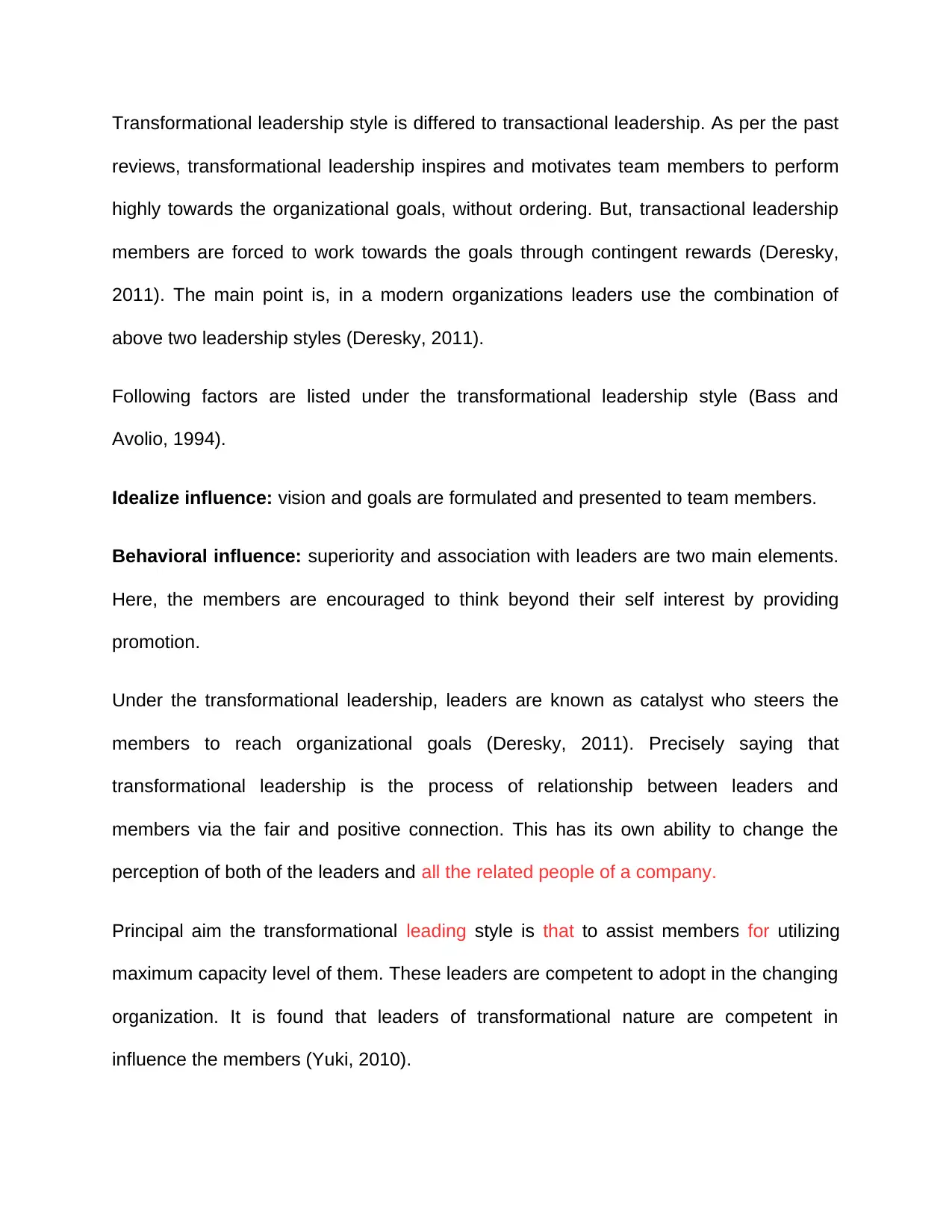
Transformational leadership style is differed to transactional leadership. As per the past
reviews, transformational leadership inspires and motivates team members to perform
highly towards the organizational goals, without ordering. But, transactional leadership
members are forced to work towards the goals through contingent rewards (Deresky,
2011). The main point is, in a modern organizations leaders use the combination of
above two leadership styles (Deresky, 2011).
Following factors are listed under the transformational leadership style (Bass and
Avolio, 1994).
Idealize influence: vision and goals are formulated and presented to team members.
Behavioral influence: superiority and association with leaders are two main elements.
Here, the members are encouraged to think beyond their self interest by providing
promotion.
Under the transformational leadership, leaders are known as catalyst who steers the
members to reach organizational goals (Deresky, 2011). Precisely saying that
transformational leadership is the process of relationship between leaders and
members via the fair and positive connection. This has its own ability to change the
perception of both of the leaders and all the related people of a company.
Principal aim the transformational leading style is that to assist members for utilizing
maximum capacity level of them. These leaders are competent to adopt in the changing
organization. It is found that leaders of transformational nature are competent in
influence the members (Yuki, 2010).
reviews, transformational leadership inspires and motivates team members to perform
highly towards the organizational goals, without ordering. But, transactional leadership
members are forced to work towards the goals through contingent rewards (Deresky,
2011). The main point is, in a modern organizations leaders use the combination of
above two leadership styles (Deresky, 2011).
Following factors are listed under the transformational leadership style (Bass and
Avolio, 1994).
Idealize influence: vision and goals are formulated and presented to team members.
Behavioral influence: superiority and association with leaders are two main elements.
Here, the members are encouraged to think beyond their self interest by providing
promotion.
Under the transformational leadership, leaders are known as catalyst who steers the
members to reach organizational goals (Deresky, 2011). Precisely saying that
transformational leadership is the process of relationship between leaders and
members via the fair and positive connection. This has its own ability to change the
perception of both of the leaders and all the related people of a company.
Principal aim the transformational leading style is that to assist members for utilizing
maximum capacity level of them. These leaders are competent to adopt in the changing
organization. It is found that leaders of transformational nature are competent in
influence the members (Yuki, 2010).
Paraphrase This Document
Need a fresh take? Get an instant paraphrase of this document with our AI Paraphraser
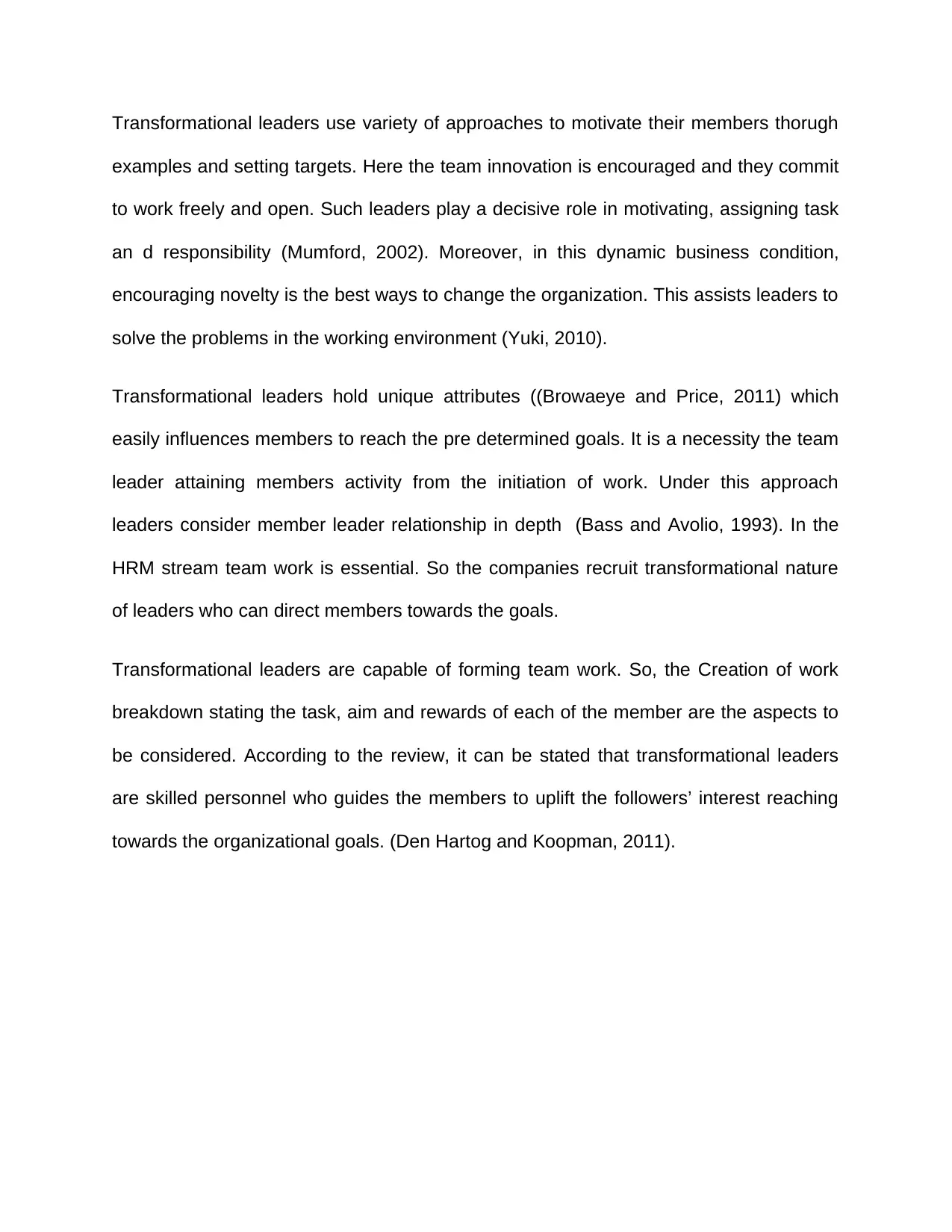
Transformational leaders use variety of approaches to motivate their members thorugh
examples and setting targets. Here the team innovation is encouraged and they commit
to work freely and open. Such leaders play a decisive role in motivating, assigning task
an d responsibility (Mumford, 2002). Moreover, in this dynamic business condition,
encouraging novelty is the best ways to change the organization. This assists leaders to
solve the problems in the working environment (Yuki, 2010).
Transformational leaders hold unique attributes ((Browaeye and Price, 2011) which
easily influences members to reach the pre determined goals. It is a necessity the team
leader attaining members activity from the initiation of work. Under this approach
leaders consider member leader relationship in depth (Bass and Avolio, 1993). In the
HRM stream team work is essential. So the companies recruit transformational nature
of leaders who can direct members towards the goals.
Transformational leaders are capable of forming team work. So, the Creation of work
breakdown stating the task, aim and rewards of each of the member are the aspects to
be considered. According to the review, it can be stated that transformational leaders
are skilled personnel who guides the members to uplift the followers’ interest reaching
towards the organizational goals. (Den Hartog and Koopman, 2011).
examples and setting targets. Here the team innovation is encouraged and they commit
to work freely and open. Such leaders play a decisive role in motivating, assigning task
an d responsibility (Mumford, 2002). Moreover, in this dynamic business condition,
encouraging novelty is the best ways to change the organization. This assists leaders to
solve the problems in the working environment (Yuki, 2010).
Transformational leaders hold unique attributes ((Browaeye and Price, 2011) which
easily influences members to reach the pre determined goals. It is a necessity the team
leader attaining members activity from the initiation of work. Under this approach
leaders consider member leader relationship in depth (Bass and Avolio, 1993). In the
HRM stream team work is essential. So the companies recruit transformational nature
of leaders who can direct members towards the goals.
Transformational leaders are capable of forming team work. So, the Creation of work
breakdown stating the task, aim and rewards of each of the member are the aspects to
be considered. According to the review, it can be stated that transformational leaders
are skilled personnel who guides the members to uplift the followers’ interest reaching
towards the organizational goals. (Den Hartog and Koopman, 2011).
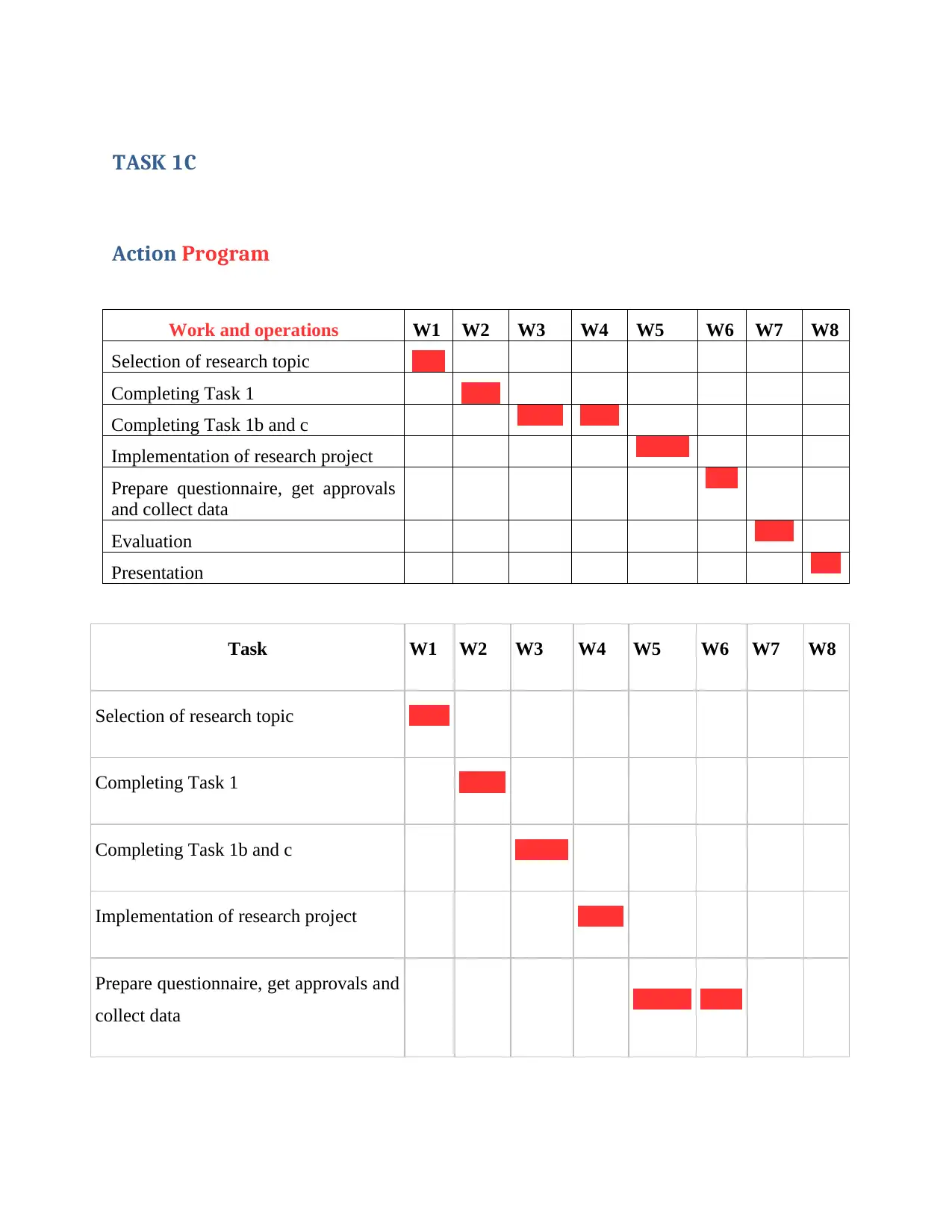
TASK 1C
Action Program
Work and operations W1 W2 W3 W4 W5 W6 W7 W8
Selection of research topic
Completing Task 1
Completing Task 1b and c
Implementation of research project
Prepare questionnaire, get approvals
and collect data
Evaluation
Presentation
Task W1 W2 W3 W4 W5 W6 W7 W8
Selection of research topic
Completing Task 1
Completing Task 1b and c
Implementation of research project
Prepare questionnaire, get approvals and
collect data
Action Program
Work and operations W1 W2 W3 W4 W5 W6 W7 W8
Selection of research topic
Completing Task 1
Completing Task 1b and c
Implementation of research project
Prepare questionnaire, get approvals
and collect data
Evaluation
Presentation
Task W1 W2 W3 W4 W5 W6 W7 W8
Selection of research topic
Completing Task 1
Completing Task 1b and c
Implementation of research project
Prepare questionnaire, get approvals and
collect data
⊘ This is a preview!⊘
Do you want full access?
Subscribe today to unlock all pages.

Trusted by 1+ million students worldwide
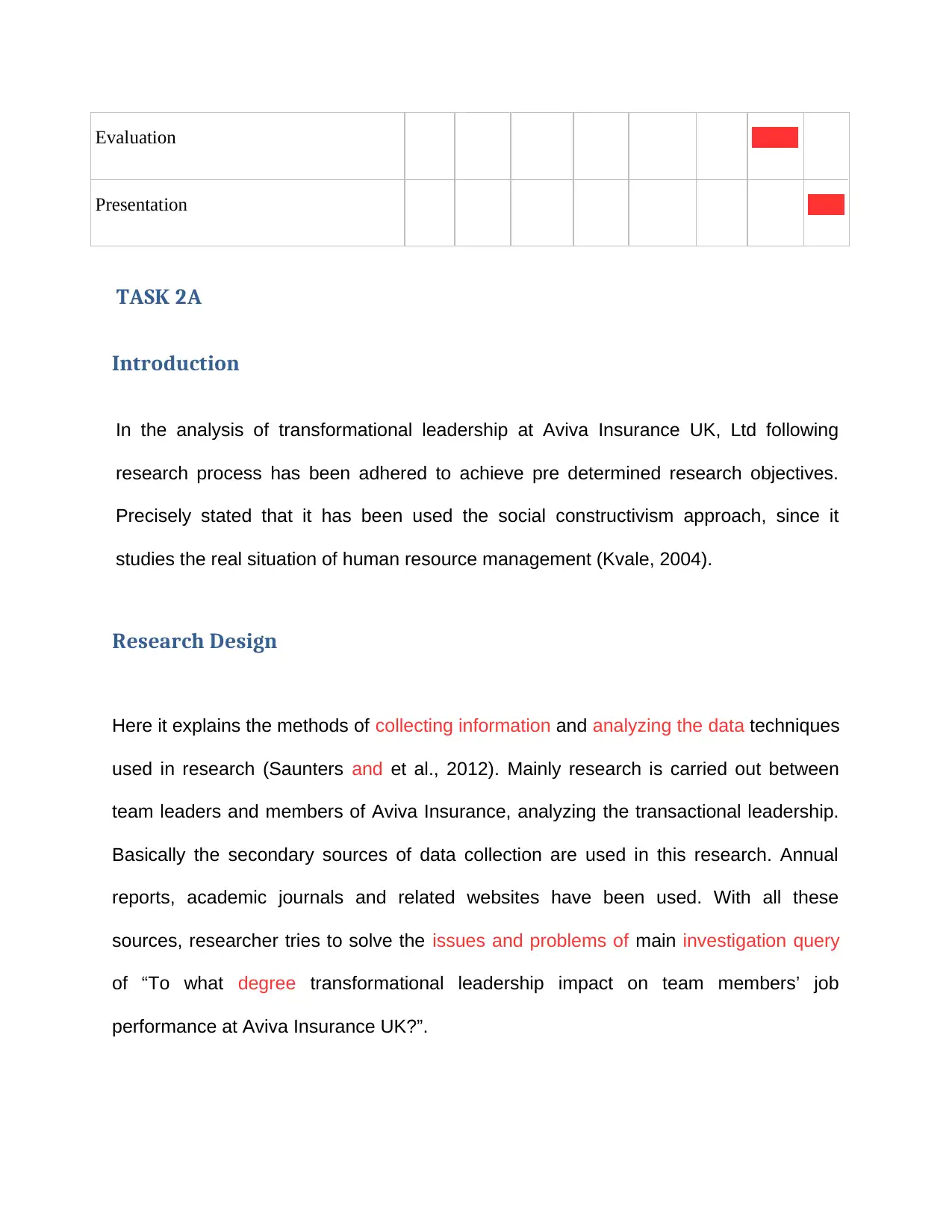
Evaluation
Presentation
TASK 2A
Introduction
In the analysis of transformational leadership at Aviva Insurance UK, Ltd following
research process has been adhered to achieve pre determined research objectives.
Precisely stated that it has been used the social constructivism approach, since it
studies the real situation of human resource management (Kvale, 2004).
Research Design
Here it explains the methods of collecting information and analyzing the data techniques
used in research (Saunters and et al., 2012). Mainly research is carried out between
team leaders and members of Aviva Insurance, analyzing the transactional leadership.
Basically the secondary sources of data collection are used in this research. Annual
reports, academic journals and related websites have been used. With all these
sources, researcher tries to solve the issues and problems of main investigation query
of “To what degree transformational leadership impact on team members’ job
performance at Aviva Insurance UK?”.
Presentation
TASK 2A
Introduction
In the analysis of transformational leadership at Aviva Insurance UK, Ltd following
research process has been adhered to achieve pre determined research objectives.
Precisely stated that it has been used the social constructivism approach, since it
studies the real situation of human resource management (Kvale, 2004).
Research Design
Here it explains the methods of collecting information and analyzing the data techniques
used in research (Saunters and et al., 2012). Mainly research is carried out between
team leaders and members of Aviva Insurance, analyzing the transactional leadership.
Basically the secondary sources of data collection are used in this research. Annual
reports, academic journals and related websites have been used. With all these
sources, researcher tries to solve the issues and problems of main investigation query
of “To what degree transformational leadership impact on team members’ job
performance at Aviva Insurance UK?”.
Paraphrase This Document
Need a fresh take? Get an instant paraphrase of this document with our AI Paraphraser
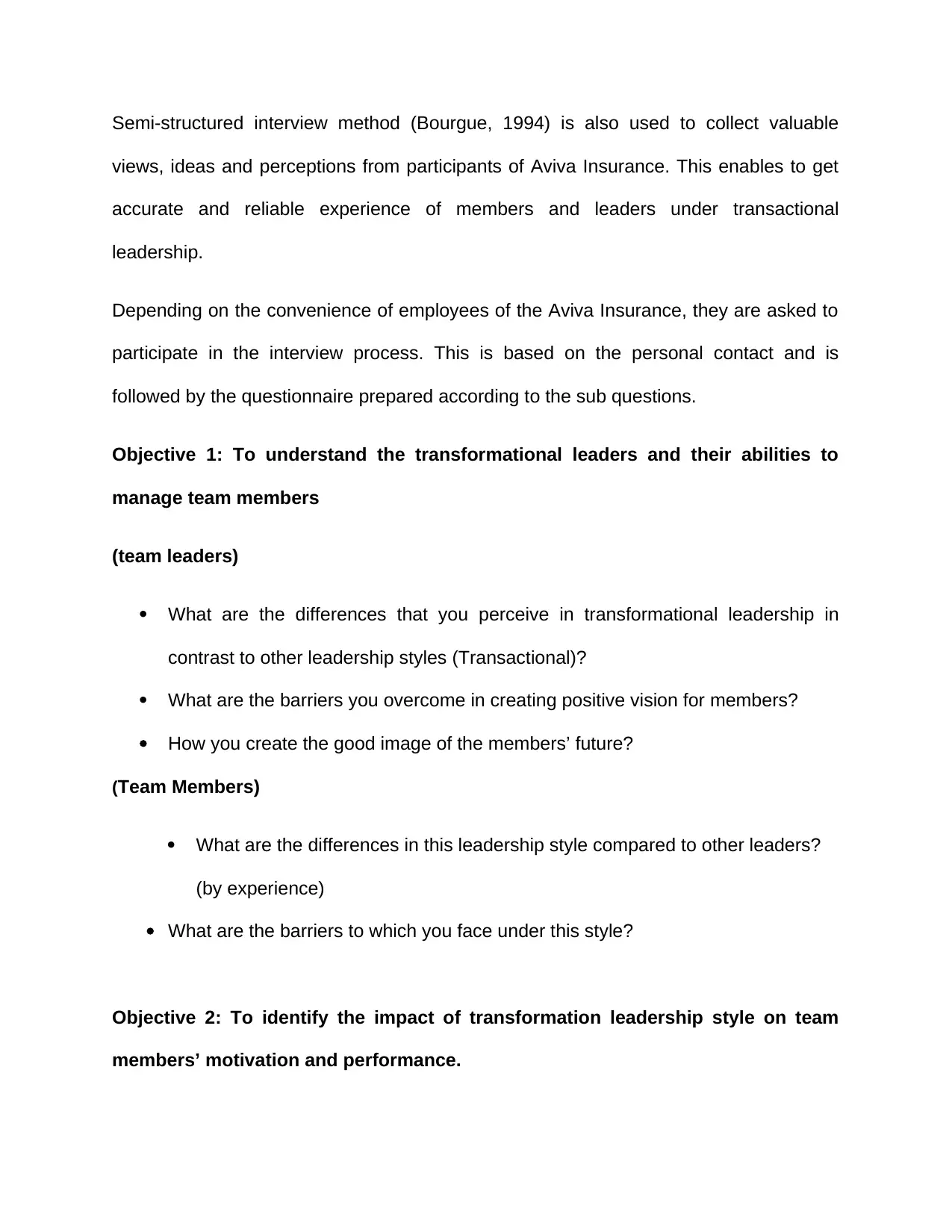
Semi-structured interview method (Bourgue, 1994) is also used to collect valuable
views, ideas and perceptions from participants of Aviva Insurance. This enables to get
accurate and reliable experience of members and leaders under transactional
leadership.
Depending on the convenience of employees of the Aviva Insurance, they are asked to
participate in the interview process. This is based on the personal contact and is
followed by the questionnaire prepared according to the sub questions.
Objective 1: To understand the transformational leaders and their abilities to
manage team members
(team leaders)
What are the differences that you perceive in transformational leadership in
contrast to other leadership styles (Transactional)?
What are the barriers you overcome in creating positive vision for members?
How you create the good image of the members’ future?
(Team Members)
What are the differences in this leadership style compared to other leaders?
(by experience)
What are the barriers to which you face under this style?
Objective 2: To identify the impact of transformation leadership style on team
members’ motivation and performance.
views, ideas and perceptions from participants of Aviva Insurance. This enables to get
accurate and reliable experience of members and leaders under transactional
leadership.
Depending on the convenience of employees of the Aviva Insurance, they are asked to
participate in the interview process. This is based on the personal contact and is
followed by the questionnaire prepared according to the sub questions.
Objective 1: To understand the transformational leaders and their abilities to
manage team members
(team leaders)
What are the differences that you perceive in transformational leadership in
contrast to other leadership styles (Transactional)?
What are the barriers you overcome in creating positive vision for members?
How you create the good image of the members’ future?
(Team Members)
What are the differences in this leadership style compared to other leaders?
(by experience)
What are the barriers to which you face under this style?
Objective 2: To identify the impact of transformation leadership style on team
members’ motivation and performance.
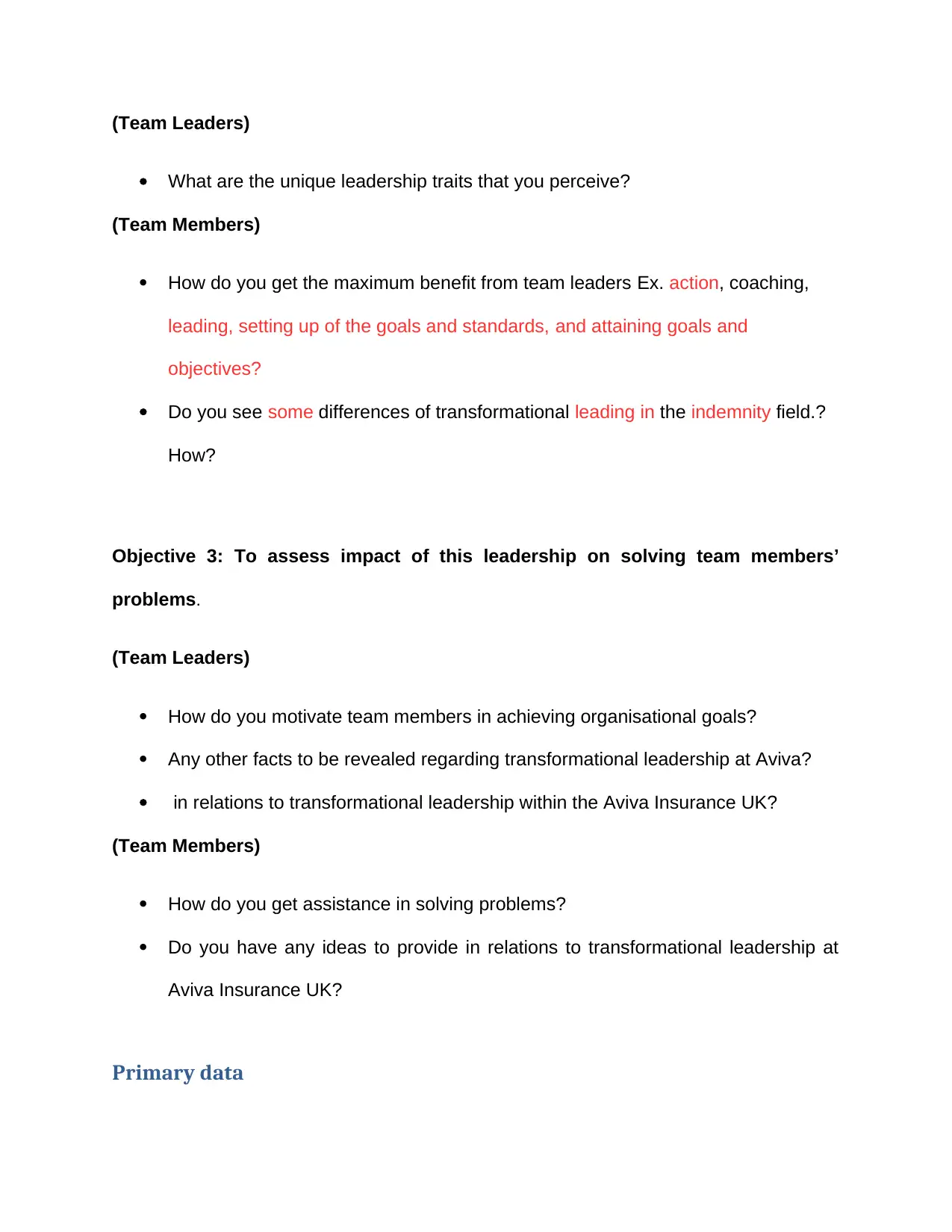
(Team Leaders)
What are the unique leadership traits that you perceive?
(Team Members)
How do you get the maximum benefit from team leaders Ex. action, coaching,
leading, setting up of the goals and standards, and attaining goals and
objectives?
Do you see some differences of transformational leading in the indemnity field.?
How?
Objective 3: To assess impact of this leadership on solving team members’
problems.
(Team Leaders)
How do you motivate team members in achieving organisational goals?
Any other facts to be revealed regarding transformational leadership at Aviva?
in relations to transformational leadership within the Aviva Insurance UK?
(Team Members)
How do you get assistance in solving problems?
Do you have any ideas to provide in relations to transformational leadership at
Aviva Insurance UK?
Primary data
What are the unique leadership traits that you perceive?
(Team Members)
How do you get the maximum benefit from team leaders Ex. action, coaching,
leading, setting up of the goals and standards, and attaining goals and
objectives?
Do you see some differences of transformational leading in the indemnity field.?
How?
Objective 3: To assess impact of this leadership on solving team members’
problems.
(Team Leaders)
How do you motivate team members in achieving organisational goals?
Any other facts to be revealed regarding transformational leadership at Aviva?
in relations to transformational leadership within the Aviva Insurance UK?
(Team Members)
How do you get assistance in solving problems?
Do you have any ideas to provide in relations to transformational leadership at
Aviva Insurance UK?
Primary data
⊘ This is a preview!⊘
Do you want full access?
Subscribe today to unlock all pages.

Trusted by 1+ million students worldwide
1 out of 27
Related Documents
Your All-in-One AI-Powered Toolkit for Academic Success.
+13062052269
info@desklib.com
Available 24*7 on WhatsApp / Email
![[object Object]](/_next/static/media/star-bottom.7253800d.svg)
Unlock your academic potential
Copyright © 2020–2025 A2Z Services. All Rights Reserved. Developed and managed by ZUCOL.


